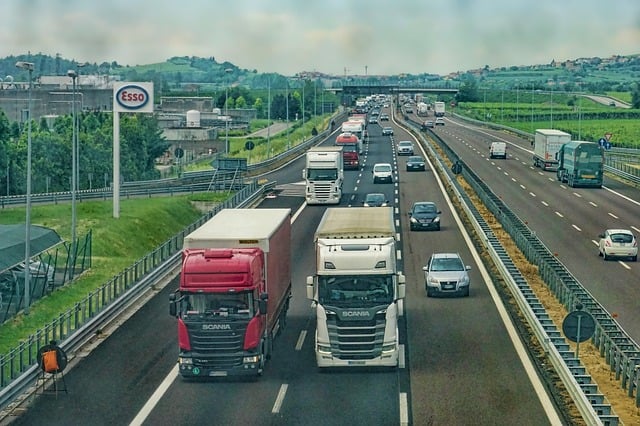
Self-driving vehicles may feel like something that will only be available in the distant future, but autonomous technology is already having an impact on the transportation industry. Many motor carriers are promoting new equipment to attract tech-savvy drivers, and advanced safety sensors are helping decrease accidents on the road.
Over 30 automakers and technology companies are working to make trucks fully autonomous, and many states have already passed self-driving legislation that allows for testing on public roads. But, even though this technology offers motor carriers a way to increase efficiency and improve safety, there are a number of topics your business needs to consider before adopting self-driving trucks.
The Different Levels of Automation
Most of the technology used in autonomous vehicles is an evolution of common safety features that use vehicle-mounted cameras and sensors, such as automatic brakes, lane departure systems and blind spot alerts. However, self-driving technology takes this concept a step further by having these systems work together to perform some or all driving functions.
Because there are multiple self-driving systems in development that offer different levels of autonomy, most companies use a system developed by SAE International to classify levels of autonomous vehicles. Levels 0-2 mainly define limited control systems that are commonly available in consumer and commercial vehicles:
- Level 0: No automation – The driver performs all driving tasks, but automated system issue warnings may be present.
- Level 1: Driver assistance – The vehicle and driver may share control in limited circumstances, such as adaptive cruise control and parking assistance. However, the driver must be ready to retake control at all times.
- Level 2: Partial automation – The vehicle has combined automatic functions (such as controlling acceleration and steering simultaneously), but the driver must be constantly engaged and aware of the surrounding environment.
Levels 3-5 define vehicles that are commonly referred to as autonomous or self-driving:
- Level 3: Conditional automation – A driver must still be present, but doesn’t have to monitor the environment. However, they must be ready to take control at all times and with no notice.
- Level 4: High automation – The vehicle can perform all driving functions under certain conditions, and switching control back to the driver may be optional.
- Level 5: Full automation – The vehicle can perform all driving functions at all times.
How Can Self-driving Trucks Help Carriers?
Self-driving trucks could help motor carriers address a number of common issues:
- Safety – Properly functioning self-driving systems operate without the chance of human error and can react to changing traffic patterns faster than a regular driver.
- Driver shortage – Regulations likely won’t allow vehicles to operate without a driver in the near future. However, the technology will attract applicants who don’t want to spend long stretches of time in full control of a commercial truck.
- Increased efficiency – Autonomous technology can give carriers real-time information on location, maintenance status and traffic patterns in order to increase efficiency and better manage fleets.
- Cost reductions – Motor carriers can reduce costs by sending autonomous trucks on more fuel-efficient routes or by platooning the vehicles together to reduce air drag.
What Risks Does This Technology Present?
Although autonomous technology is advancing rapidly, there are still a number of risks and obstacles to overcome before the vehicles can be widely adopted:
- Public perception – Advanced sensors generally make self-driving trucks safe, but recent high-profile collisions and fatalities during tests have lowered the public’s opinion of the technology.
- Long-term employment – Autonomous technology will help to attract new drivers in the near future, but some experts believe that fully independent vehicles may someday eliminate millions of jobs.
- Liability – The liability of an accident involving human-driven vehicles is fairly easy to judge. However, self-driving trucks bring a nonhuman factor into the equation that makes it difficult to determine if an operator, technology developer, manufacturer or other party is at fault for an accident.
- Compliance – Individual states, cities and jurisdictions currently manage laws regarding the testing and use of self-driving trucks, making interstate commerce more complicated. However, the FMCSA recently requested feedback on the regulations that would have to be updated, modified or eliminated to safely allow for the use of autonomous vehicles. Key questions discussed by the agency include the following:
- How will motor carriers ensure automatic systems are functioning properly?
- What changes, if any, should be made to distracted driving regulations?
- How will enforcement officials determine a vehicle’s SAE classification level, and would easily identifiable classification signage negatively affect other drivers?
- How should a driver’s hours of service be recorded when using an automated driving system?
Considering Your Options
As self-driving vehicles continue to develop, your business should carefully consider how both the advantages and risks of this new technology will impact its operations. Contact us at 831-661-5697 today for help analyzing your unique risk exposures.
Read more

Ticks and Lyme Disease
Lyme disease is a bacterium that’s often carried by mice and other small rodents. The disease can be transmitted to humans if they’re bitten by a tick that previously fed off an infected animal.
Different types of ticks live in the United States and while some can transmit diseases, others are only a nuisance. In general, infected blacklegged ticks can transmit the bacterium that causes Lyme disease.
Symptoms of Lyme disease typically develop within two weeks of a tick bite and can include fevers, chills, swollen lymph nodes, neck stiffness, fatigue, headaches, and joint or muscle aches.
To avoid contracting Lyme disease, do the following:
- Wear light-colored clothing, including long-sleeved shirts and pants when in wooded areas. Tuck pant legs into socks or boots and keep long hair tied back.
- Wash your body and clothing after all outdoor activities.
- Look periodically for ticks if you’ve been outdoors, especially if you’ve been in wooded areas or gardens.
- Remove ticks within 24 hours to greatly reduce the risk of contracting Lyme disease.
- Check your pet’s coat if it’s been in an area known for ticks.
Remember to consult your health care provider as soon as you experience Lyme disease symptoms. If possible, send any ticks that you’ve removed to a public health laboratory in your area. Click here to learn more.
Keeping Mold Out of the Home
A mold problem in the home can cause serious health effects, especially for young children, the elderly, those who suffer from allergies or asthma, and those with prior respiratory conditions. Mold can cause eye irritation, nasal stuffiness, shortness of breath, wheezing and infections in the lungs.
Though most molds grow outdoors, they can get inside a home through open windows and doors, air conditioning systems, pets, clothing and shoes. Try these prevention tips to keep mold out of your home:
- Clean up any water damage or flooding thoroughly and immediately.
- Use a dehumidifier and a wet-dry vacuum to remove water quickly.
- Remove carpeting that can’t be dried out within 48 hours. If your carpet was contaminated by sewer water or a flood, it needs to be replaced.
- Repair basement cracks so that moisture can’t seep in.
- Use a dehumidifier or air conditioner to reduce indoor moisture, especially during humid months. Empty the drip pans in your air conditioner, refrigerator and dehumidifier on a regular basis to prevent water buildup.
- Fix plumbing leaks immediately. Mold will begin to grow within 24 to 48 hours after a leak forms.
Protecting Your Vehicle from Hail
Hail can strike anywhere and at any time, causing major damage to your vehicle. When a hailstorm occurs, take the following precautions to keep you and your vehicle safe:
- Don’t get out of your vehicle if you’re driving during a hailstorm. If you can pull over to the side of the road, do so safely.
- Park your car on an angle so that the hail hits the front of your car. This protects your side and rear windows, which aren’t made of reinforced glass.
- Find covered parking to protect your car, like a parking garage or awning. If you live in a hailstorm-prone area, it may be a good idea to purchase or build a covered parking solution for your home, like a metal canopy or garage.
- Use blankets or a hail car cover. These items can be very effective in protecting vehicles from damage, especially if you’re far away from shelter.
- Locate a body shop that you trust to make any necessary repairs. Discuss the extent of the damage with the body shop and your insurance broker.
Hotel Safety Tips
Hotels provide a home away from home whenever you travel. However, hotels aren’t always safe, and vacationers are at risk of things like break-ins, fires and natural disasters.
The following are some general hotel safety tips to keep in mind to protect yourself from a variety of risks:
- Check reviews for security concerns. Guest reviews can provide information on the area’s crime level and steps the hotel takes to protect guests.
- Use hotels that restrict access to guest floors.
- Check your room lock to confirm it’s working properly. Make sure that the door has a deadbolt and keep it locked whenever you’re in the room.
- Lock away valuable items you won’t be carrying with you in the room’s safe. This can include things like money, jewelry, laptops or other electronics.
- Be wary of people that come to the door claiming to be hotel staff.
Read more

The right auto policy can be invaluable following a vehicle theft. If you have comprehensive coverage on your policy, your insurer can help pay to replace your lost car. Most policies can even provide rental car coverage until your stolen vehicle is recovered or considered lost. For more information on car insurance, contact Scurich Insurance today.
If you suspect your vehicle has been stolen, do the following:
Call the police. The sooner you notify the proper authorities, the more likely you are to recover your vehicle. You will want to share everything about your car that you can, including its make, model, licence plate number and VIN number.
Report the stolen car to your insurer. Once you’ve completed a police report, you should contact your car insurance company. You can often file a report using your insurer’s claims hotline. You should also consider contacting your local motor vehicle department, as they typically maintain a database of stolen vehicles.
Report the theft to your finance or leasing company. If you still owe money to a financing or leasing company, you will want to inform them that your vehicle has been stolen. Often, these companies work directly with insurers following vehicle thefts.
While there’s a chance authorities may recover your stolen vehicle, it’s best to try to prevent thefts altogether. Make sure you always lock your car and take your keys with you. Never keep a spare set of keys hidden in your car or leave the vehicle running unattended. Parking in well-lit areas and hiding valuables that might attract thieves can also be useful.
Read more

The Problem with Minimum Coverage
Most states require drivers to carry basic liability coverage, which pays for injury and property damages if you are found at fault following an accident. These limits vary by state but can be as low as $10,000 per person or $20,000 per accident.
If you get into an accident, there’s a chance you could be sued. When this happens, minimum liability coverage may not be sufficient to cover the damages, and you could end up paying thousands of dollars out of your own pocket.
What’s more, if you cause an accident and your liability limits are too low to cover the expenses, the other party might go after your assets in court. To protect yourself, it’s important to think critically about how much coverage you need and to secure the proper limits.
How Much Auto Insurance Should I Carry?
While it can be tempting to simply pay the lowest amount possible for auto insurance, doing so can leave you exposed to serious financial risks. In general, it’s recommended that you carry more than the minimum coverage unless you are driving an older car with little value and have no assets to protect.
Did You Know? Insurance is mandatory in order to operate a vehicle in the United States, and every state has specific coverage limits that you must meet. While meeting these minimum limits may be enough to get you on the road, they are often inadequate if you are involved in a serious accident. As such, you may want to consider raising your limits in order to secure the right protection.
The higher you set your coverage limits and the lower you set your deductibles, the less you’ll pay out of pocket after a claim. You will need to determine how much you can comfortably afford when setting your coverage limits and deductibles.
Raising your limits and paying a little more each month will allow you to get the most out of your investment.
Customize Your Policy
When it comes to auto insurance, you have many options. Contact your insurance broker today. They will be able to discuss different ways to customize auto insurance policies, including adjusting collision, comprehensive, medical expenses, uninsured motorist and no-fault coverage. They can also recommend specific policy limits given your situation.
Read more

The Insurance Research Council reports that an estimated 1 in 7 drivers in the United States are currently uninsured. As a result, many car insurance companies across the nation offer specific coverage in the event that you get into an accident with an uninsured driver, such as uninsured motorist (UM) coverage and underinsured motorist (UIM) coverage.
UM coverage applies if the uninsured driver was at fault in the accident or if you were the victim of a hit-and-run accident. UIM coverage applies if the other driver is at fault and lacks a high enough level of coverage to cover the cost of the accident. This means that if the underinsured driver’s policy limit is reached before the cost is covered, your insurance company would pay the remainder of the costs until your coverage limit is reached.
While UM/UIM coverage can be helpful, often times the level of coverage isn’t enough to cover the costs of the accident. Luckily, several states allow you to “stack” your UM or UIM coverage. Read on to learn the differences between stacked and unstacked UM/UIM coverage.
Unstacked Coverage
If you have unstacked UM/UIM coverage, your level of coverage is the limit on your policy. For instance, if you have a set limit of $20,000, that is the maximum amount of coverage you will receive after an accident with an uninsured or underinsured driver. Unstacked coverage is more common than stacked coverage, seeing as it is your only option if you insure just one car.
Stacked Coverage
If you insure multiple vehicles and your state allows stacking, you are permitted to increase your level of UM/UIM coverage. You can utilize stacked coverage within one policy, or across policies.
Stacking your coverage within one policy means you are combining your coverage limits for multiple vehicles on a singular policy. For example, if you own two cars on one insurance policy and your UM/UIM limit is $20,000, you can combine your coverage limits for a total of $40,000.
Using stacked coverage across policies means you are combining your coverage limits between separate policies for a singular claim. For example, if you own two vehicles, each with separate policies and your UM/UIM limit is $25,000, you could file a claim using both policies, therefore using up to $50,000.
The Advantages and Disadvantages
There are both benefits and drawbacks to utilizing stacked UM/UIM coverage. Stacking can potentially raise the amount of coverage you can use in case of an accident with an uninsured or underinsured driver, and lets you increase your UM/UIM limits without increasing your liability coverage.
However, if you have stacked coverage, you may have higher rates, seeing as car insurance companies have to offset the risk of costly reimbursement.
In addition, while some states lack laws for stacked coverage, some states either forbid it or only allow it in specific circumstances. Aside from state laws, some car insurance companies have certain policies that disallow stacked coverage. Be sure to contact your car insurance company to discuss your options with stacked UM/UIM coverage.
Read more

5 Tips to Improve Your Mental Health
Staying healthy is about more than paying attention to your physical body—your mental health directly influences how you think, feel, react and maintain relationships. If you don’t take steps to promote your mental health, you may find that anxiety, depression and irritability can take control of your life.
According to the National Alliance on Mental Illness, about 1 in 5 adults experience some form of mental illness in a given year, but less than half of them seek professional treatment. And, even if you haven’t been diagnosed with a mental illness, taking steps to improve your mental well-being can improve your physical health and help you maintain positive relationships.
Here are five tips you can use to help improve your mental health:
- Talk with those who care about you. Simply talking to friends, family members or co-workers can help you overcome a personal problem and stay connected.
- Take a break from digital distractions. Although smartphones and other modern technology make it easy to stay connected with others, focusing too much on digital media can make it easy to ignore close relationships and the world around you.
- Take care of your body. Your brain is still part of your physical body, so it’s important to exercise regularly, maintain a healthy diet and get enough restful sleep.
- Set realistic goals and focus on taking the first step. Many projects or errands can seem overwhelming when taken as a whole. Try planning out steps for large tasks and concentrate on what you need to do first.
- Get help when you need it. Although there can be negative social stigmas about seeking help for mental or emotional problems, mental health professionals are trained to help manage stress and mental illnesses with therapy or medication.
The Dangers of Carbon Monoxide
Carbon monoxide (CO) is a toxic gas that’s produced by the incomplete burning of any fuel, including gas, fire and wood. Many of the appliances in your home produce harmless amounts of CO. However, if these appliances aren’t properly maintained or ventilated it could lead to a hazardous buildup of CO. And, because the gas is colorless, odorless and tasteless, it can be easy to remain unaware of potentially dangerous levels of CO in your home.
Symptoms of mild CO poisoning can include flu-like symptoms, such as headaches, nausea and weakness. However, exposure to large amounts of CO for an extended period can be fatal. Follow these steps to prevent a buildup of CO in your home:
- Install CO detectors on every level of your home. Also, never assume that your home’s smoke alarms can also detect CO.
- Check your appliances every year to ensure that they’re in safe working order and have sufficient airflow around them. Appliances that emit CO include fireplaces, water heaters, portable generators, power tools, lawn equipment, and gas- or wood-burning cooking appliances.
- Never leave a car or other motorized vehicle running in an attached garage, even if the garage door is open.
- Never rely on ovens, gas grills or other appliances to heat your home.
- Contact a specialist to ensure that your chimneys, vents and flues are providing sufficient ventilation to your home.
For more information on protecting your home from CO and other dangerous gases, such as radon and natural gas leaks, contact us today at 831-661-5697.
Removing Distractions Before You Drive
Distracted driving is a serious and deadly problem. According to the National Highway Traffic Safety Administration, distracted driving leads to over 3,000 deaths and 375,000 injuries every year. Although many conversations about distracted driving focus on cellphones, the truth is that any distraction can be enough to cause a deadly accident. The following list includes some of the ways you can remove distractions and keep yourself safe on the road:
- Get plenty of rest before you drive. Studies have shown that fatigued drivers perform just as poorly as those who drive while intoxicated.
- Know where you’re going and the road conditions before you drive. Looking at a map or having to focus on the weather can take your attention off of the road and surrounding traffic.
- Secure any items in your vehicle that may roll around. You may be tempted to reach for them while you’re driving.
- Don’t use your cellphone or a hands-free device while driving. If you absolutely must contact someone, pull over to the side of the road first.
Read more






